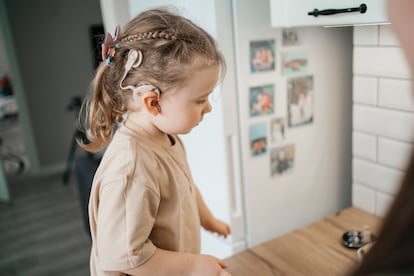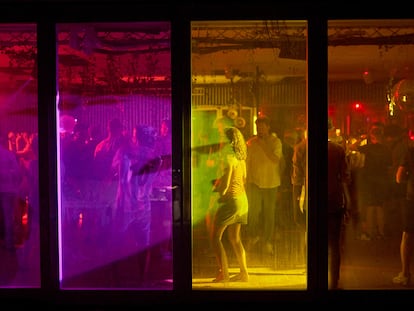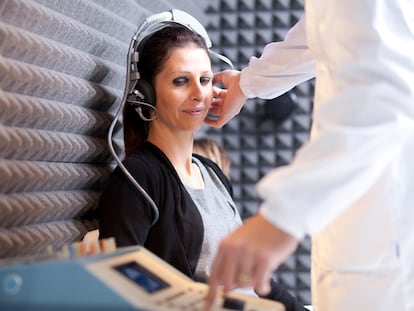TV, toys and schoolyards: The everyday sounds that can affect children’s auditory development
A scientific review warns of the need to raise awareness among parents and guardians about the risks that noisy environments pose to little ones

It’s well known that going to a nightclub and being exposed to 100 decibels for hours isn’t suitable for hearing health. In fact, any prolonged exposure to a sound that exceeds 80 decibels begins to be problematic. However, it’s less known that, for young children, the situation is much more delicate. Ordinary sounds — such as the noise of traffic, television playing in the background, or even certain toys — can permanently affect the hearing abilities of small children.
This warning has been issued by the American Academy of Pediatrics in a scientific review published in The Journal of Pediatrics. “Noise exposure is a significant public health problem that requires urgent attention. The effects on hearing and quality of life in the early stages can affect the lifetime trajectory of children. We’re in need of an urgent wakeup call,” urges Dr. Brian Reilly, one of the authors of the report.
The risk to children is greater than adults, due to differences in the anatomy of the external ear. The smaller the channel, the greater the intensity at the highest frequencies. At birth, the external ear is approximately six kilohertz. By the second year of life, this number decreases to three. The ear canal reaches adult size and orientation around the age of nine, while the middle ear cavity doesn’t reach adult size until adolescence. However, it’s only around the age of 20 that the maturation of the auditory pathways and cortex is achieved. This means that — for the first two decades of life — young people are considerably more susceptible to developing hearing loss or problems.
“Even small amounts of hearing loss can have profound and negative effects on speech, language comprehension, communication, classroom learning and social development,” the report’s authors highlight. Another study — published in the journal JAMA Otolaryngology — estimates that one in six American teenagers has hearing problems. The authors recognize that it’s necessary to further investigate the link between noise exposure and early hearing loss. Similarly, they insist on the need — on the part of pediatricians — to raise awareness of preventative measures before treatments. “At the end of the day, babies and young children are at the mercy of parents and caregivers to protect them from excessive and unnecessary levels of harmful noise. It’s up to [guardians] to protect the hearing health of the little ones,” Dr. Reilly insists.
“[As specialists], it’s difficult for us to convey that the hearing we lose is impossible to recover. That’s why it’s so important to avoid situations that can damage our hearing as much as possible,” explains Luis Lassaletta, president of the Otology commission at the Spanish Society of Otorhinolaryngology. The doctor — who didn’t participate in the recent study — emphasizes that the age range when hearing problems begin has gradually been decreasing. “Hearing loss — which was previously assumed [to start] at 70 to 80-years-old — now begins at 50 or 60.”
Pediatrician Gonzalo Pin — coordinator of the Sleep and Chronobiology Group at the Spanish Association of Pediatrics — notes that the recent publication conveys “very interesting research, because even though noise pollution is the little sister of light pollution [among children], it’s not given the same attention.”
“Until the industrial revolution, the noises we had were thunder, storms and little else. The range of sounds we now have puts our hearing health to the ultimate test,” the doctor warns.
Out of children’s control
One of the factors that most endangers the hearing health of young people is personal listening devices. “The use of headphones at excessively high volumes is incredibly common among children and adolescents. This is an important area that parents and pediatricians should focus on in regards to prevention efforts,” advises Dr. Gonzalo Pin. In fact, 23.8% of young people who use personal audio devices at high intensity or go to entertainment venues with loud music are at risk of suffering some type of deafness or hearing damage, according to a study in BMJ Global Health.
Many devices already have a built-in alert system that warns users when they’re exceeding the recommended amount of decibels. Some of these systems provide weekly reports on the audio level of the headphones. Certain devices even allow users to activate an option that automatically reduces sounds that exceed 80 decibels, which many studies identify as the maximum intensity that the ear should withstand. “For me, it comes down to the fact that if you have to take off your headphones to hear what your parents are trying to tell you, it means that the volume is too high,” Dr. Lassaletta says.
There are other factors that affect infants and school-aged children to a greater extent, which the American Academy of Pediatrics analyzes in the report. The background noise of television, for example, can be disruptive for little ones, especially when exposure is continuous and exceeds four hours a day. “It’s important to remember that noise exposure not only includes intensity, but also duration and frequency,” the authors emphasize.
Attention must also be paid to academic environments. It’s essential that measures are adapted to ensure that 35 decibels aren’t exceeded at least 80% of the time. “Once you realize how loud places that are supposedly kid-friendly can be, it’s hard to ignore what your own ears are telling you: too loud, please turn it down,” Reilly warns.
Sign up for our weekly newsletter to get more English-language news coverage from EL PAÍS USA Edition
Tu suscripción se está usando en otro dispositivo
¿Quieres añadir otro usuario a tu suscripción?
Si continúas leyendo en este dispositivo, no se podrá leer en el otro.
FlechaTu suscripción se está usando en otro dispositivo y solo puedes acceder a EL PAÍS desde un dispositivo a la vez.
Si quieres compartir tu cuenta, cambia tu suscripción a la modalidad Premium, así podrás añadir otro usuario. Cada uno accederá con su propia cuenta de email, lo que os permitirá personalizar vuestra experiencia en EL PAÍS.
¿Tienes una suscripción de empresa? Accede aquí para contratar más cuentas.
En el caso de no saber quién está usando tu cuenta, te recomendamos cambiar tu contraseña aquí.
Si decides continuar compartiendo tu cuenta, este mensaje se mostrará en tu dispositivo y en el de la otra persona que está usando tu cuenta de forma indefinida, afectando a tu experiencia de lectura. Puedes consultar aquí los términos y condiciones de la suscripción digital.
More information
Últimas noticias
Most viewed
- Reinhard Genzel, Nobel laureate in physics: ‘One-minute videos will never give you the truth’
- Oona Chaplin: ‘I told James Cameron that I was living in a treehouse and starting a permaculture project with a friend’
- Pablo Escobar’s hippos: A serious environmental problem, 40 years on
- Why we lost the habit of sleeping in two segments and how that changed our sense of time
- Chevy Chase, the beloved comedian who was a monster off camera: ‘Not everyone hated him, just the people who’ve worked with him’











































